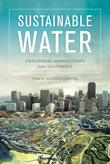Sustainable Water: Challenges and Solutions from California

Sustainable Water is edited by Allison Lassiter and was conceived from her lecture series called “Planning for Water Sustainability in the 21st Century”. Grounded in California, a US state familiar with pervasive drought, this book brings together 15 essays by experts in the field of water, be it law, ecology, engineering or planning. The aim of the book is to illustrate an alternative path to managing the state’s finite water supplies – one that is flexible and resilient rather than one based out of emergency and crisis. As such, Sustainable Water is an interdisciplinary guide for not only California’s future, but the future of urban areas around the world.
Lassiter structures the book into six categories, which address the critical challenges that California faces in managing its water. These are: adapting to climate, defining water access and ownership, managing risks, integrating institutions, representing vulnerable communities, and reducing consumption. Each of these categories contains two to three chapters. The book is also structured by geographic scale; it starts with statewide policies and moves down through regional systems, and then communities, to personal water use. Hemming in the book are an introduction by Lassiter and an afterword by Peter Gleick, a leading expert in global climate and water issues.
Chapter 1 looks at adapting California’s water sector to a changing climate. It thus highlights the likely impacts climate change will have upon California’s water and the importance of adapting California’s water management to ensure the sustainability of its water resources. Chapter 2 explores the nexus among water, energy and climate, and in light of the challenges and opportunities proposes conceptual and methodological approaches to managing both water and climate.
The second category on defining water access and ownership also contains two chapters. Chapter 3 discusses the history of California’s surface water rights, in particular riparian and appropriative rights, and identifies its flaws in relation to the Delta and the weaknesses of the State Water Resources Control Board (SWRCB). Chapter 4 looks at the law and policy that governs California’s water resources. It highlights how this “Reasonable Use Doctrine” will be an essential guide for California as it faces future water resource challenges.
The third category on managing risks contains three chapters. Chapter 5 identifies patterns of water use in California and uses this to discuss both urban water demand and pricing and sustainable water pricing. Chapter 6 focuses on the Delta, its floods, and the infrastructure used to protect California’s water supply system, and advocates creating a “coordinated GIS risk and real-time management system”. Chapter 7 then considers tools available to manage water scarcity, and in particular reviews how portfolio-based planning can bring together and increase the effectiveness of water management actions.
The fourth category on integrating institutions also contains three chapters. Chapter 8 reviews how California developed its environmental and economic problems associated with unconstrained pumping of groundwater. It then goes on to explore how to resolve these. It emphasizes the importance of formally regulating groundwater pumping and linking it to surface water management and use. Chapter 9 studies the Santa Ana Watershed Project Authority’s One Water One Watershed plan to illustrate how an integrated water resource management process can achieve better water management by considering all the water resources and stakeholders within a watershed. Chapter 10 then tracks the history of California’s intentional reuse of municipal wastewater. It highlights the associated challenges as well as the need for a philosophical shift that regards wastewater as a valuable resource.
Vulnerable communities are the focus of the fifth, penultimate category. The first of three chapters, Chapter 11 tells the story of contaminated drinking water in the Tooleville community, California and provides a Drinking Water Disparities Framework by which to “understand environmental justice in the context of drinking water”. Chapter 12 looks at California’s native salmon, detailing their links with environmental flows and considering the effects of restoration efforts, water management practices and climate change upon these. Chapter 13 then explores incorporating an adaptive management approach into relicensing of hydroelectric projects in California, so that findings on how ecosystems respond to changes in stream flow can inform flow management.
The final category looks at reducing consumption and contains two chapters. Chapter 14 details how drawing upon both residential rainwater and greywater supplies can reduce household water use. It also identifies what infrastructural constraints currently exist for small, decentralized water systems in California’s cities, and how the use of “small water” can foster new water cultures that have the potential to impact upon policy (page 319). Finally, Chapter 15 discusses the assessment tool known as a “water footprint”. After presenting the science behind this tool, the chapter presents California as a case study. It critically examines the variability and uncertainty of the water footprint as well as its future role in sustainable water management.
Book note prepared by Hannah Keren Lee
Search the Book notes database
Our Book notes database contains details and summaries of all the publications included in Book notes since 1993 - with details on how to obtain/download.
Use the search form above, or visit the Book notes landing page for more options and latest content.
For a searchable database for papers in Environment and Urbanization, go to http://eau.sagepub.com/

